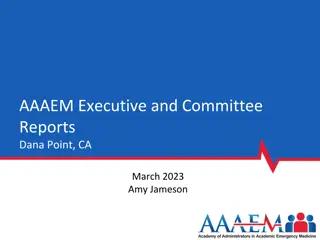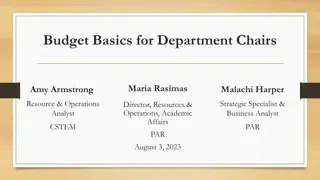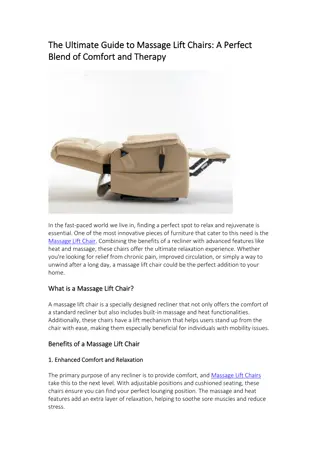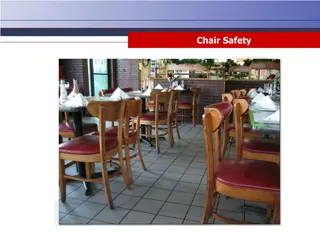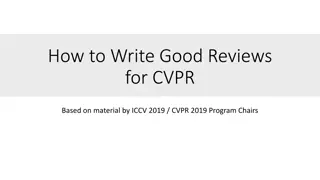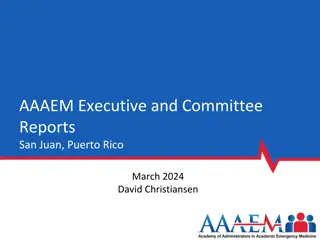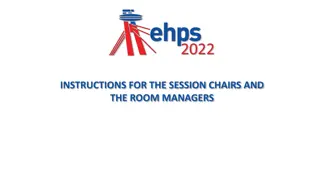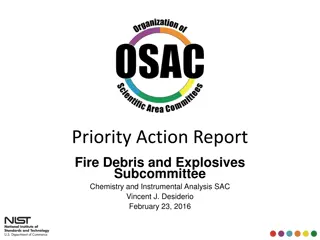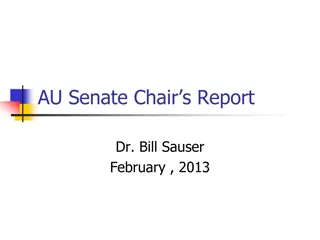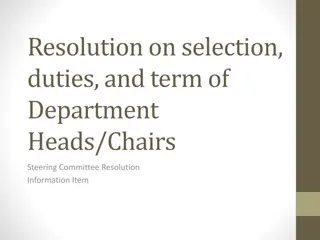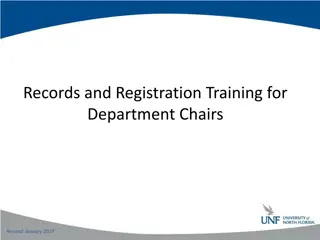Training Guidelines for SEMPC Committee Co-Chairs
Explore essential training topics, objectives, and detailed roles and responsibilities for new committee co-chairs at Southeast Metro Planning Council (SEMPC), including operational insights, staff support, policies usage, and meeting management. The content covers work plans, meeting agendas, committee member recruitment, meeting chairing, documentation needs, collaboration with other committees, and more to ensure effective committee functioning.
- Training Guidelines
- SEMPC Committee Co-Chairs
- Roles and Responsibilities
- Meeting Management
- Staff Support
Download Presentation

Please find below an Image/Link to download the presentation.
The content on the website is provided AS IS for your information and personal use only. It may not be sold, licensed, or shared on other websites without obtaining consent from the author. Download presentation by click this link. If you encounter any issues during the download, it is possible that the publisher has removed the file from their server.
E N D
Presentation Transcript
Training for New Committee Co-Chairs Southeast Metro Planning Council (SEMPC)
Training Topics Committee Co-Chair Roles and Responsibilities How SEMPC Committees Operate Available Staff Support Tools for Committee Co-Chairs 2
Training Objectives Following the training, new committee co-chairs will be able to: 1. List and describe their roles, including pre-meeting, meeting, and follow-up responsibilities 2. Describe how SEMPC s committees operate, in terms of membership, access to information, decision making, and reporting their work & recommendations to the full PC 3. Explain the support PCS staff will provide and the limits of that support 4. Identify the written policies and procedures they expect to use in their roles as committee co-chairs 3
Roles and Responsibilities of Committee Co-Chairs Summary of Roles and Responsibilities Work Plans Meetings 4
Roles for SEMPC Committee Co-Chairs Develop, follow, and monitor progress on committee work plan Develop committee meeting agendas and work with staff to identify data, materials, and staffing needs for meetings Help recruit committee members as appropriate During meetings: Chair and manage meetings, following Bylaws, policies and procedures, and agreed-upon decision-making process Ensure availability of needed materials; project during discussion if possible Document action items and help prepare minutes (using template provided) 5
Roles for SEMPC Committee Co-Chairs (cont.) Ensure meeting follow up Arrange training & mentoring for committee members Help prepare/review work products/reports Work collaboratively with other committees Represent/report for the committee at Executive Committee and PC meetings Share these roles between co-chairs 6
Minutes Template: Committee Meeting Committee Name: Meeting Date and Time: Meeting called to order at ________, adjourned at _________ Location: Attendance: [Identify Co-Chairs, members, PCS staff, recipient staff, and members of the public] Brief Summary of Agenda [Use bullets & attach copy of Agenda] Items Discussed Topics and Summary of Discussion [For each topic, use bullets, and include any votes or recommendations to the PC, issues/next steps] 7
Quick Discussion: Committee Chair vs. Co-Chairs Each SEMPC committee now has two co-chairs elected by the committee membership, and Bylaws strongly urge that at least one co-chair be a consumer. Until three years ago, committees had a single chair, appointed by the SEMPC Co- Chairs. Discuss the following: What are some advantages of having committee co-chairs rather than a single chair? Can you think of any disadvantages, and if so, what are they? 8
SEMPC Work Plan Format Deadline/ Completion Date Products or Deliverables # Major Tasks/Activities Responsibility 1 2 3 4 5 6 9
HRSA HAB Expectations for Meetings Open meeting, held following public notice Conflicts of interest declared and managed Use of parliamentary or other decision-making procedures as stated in Bylaws Public comment period Code of Conduct enforced for members and public Active participation by consumers, providers, and other members Recipient staff present PCS staff support for Chair and members 10
Roles of the Co-Chairs in Successful Committee Meetings 1. Recognize the importance of meetings 2. Work closely with PCS staff to plan the meeting 3. Help develop and fully understand the agenda 4. Be sure needed materials are provided and when possible projected during the discussion 5. Be sure materials that might be needed for reference (such as, Bylaws, policies & procedures) are readily available 11
Co-Chair Roles during a Committee Meeting Communicate: Start the meeting, welcome members, make introductions, address agenda, set the scene Control: Maintain control, manage time, be flexible but keep to the agenda Coax: Encourage full participation without anyone dominating; ask hard questions and raise hard issues Compare: Summarize various views presented Clarify: Make sure everyone understands the discussion, and minimize jargon and technical terms 12
Co-Chair Roles during a Committee Meeting (cont.) Support decision making: Ensure that decisions are made and that they reflect SEMPC s purposes, ensure that decisions are recorded and included in the minutes, and have someone assigned to implement them Guide: Guide the meeting, helping members work as a productive team, and managing time End the meeting: Summarize decisions made, follow-up actions needed, and focus items for the next meeting 13
Quick Scenario: Sharing Responsibilities Work in pairs. Assume you are the newly elected co-chairs of a SEMPC committee. One of you has been on the PC for several years and has one more year before cycling off due to term limitations. The other just completed one year as a member. Neither of you has been a co-chair before, but the experienced member has a lot of community planning experience. Given this situation, how might you decide to divide or share co-chair responsibilities? Why did you choose this approach? If both co-chairs had been on the PC for two years, would you suggest a different division of responsibilities? Why or why not? 14
Roles of Committee Co-Chairs in Engaging Members Explain the committee s roles, to help SEMPC members choose their committee Help recruit non-SEMPC members if your Bylaws allow non- members to serve Help orient, train, and mentor new committee members Motivate members to participate/contribute actively in committee meetings Provide a welcoming environment Identify concerns and resolve problems that may negatively affect member participation 15
How SEMPC Committees Operate, with Staff Support Requirements and Procedures Staff Support Collaboration across Committees Consumer and Community Input Commitment to Inclusive Planning 16
SEMPCs Four Committees Planning Committee: Needs Assessment and Integrated/Comprehensive Planning Care Strategy Committee: Priority Setting and Resource Allocation (PSRA), Service Standards, Assessment of the Administrative Mechanism (AAM) Membership and Operations Committee Consumer Committee 17
SEMPC Committees: Overview Carry out legislative responsibilities Do much of the work of SEMPC Public input and always a public comment period Consultation with outside experts In-depth discussion Generally meet monthly Make recommendations to Executive Committee, then to full PC Enable PC meetings to be used for review, decision making, new information, and big-picture issues 18
Committee Requirements and Procedures Committee assignments: Each PC member expected to serve actively on one standing committee (no more than 3 absences per year) Members express preferences in writing to SEMPC Co-Chairs SEMPC Co-Chairs make committee assignments annually Membership Committee helps recruit non-members to serve on non-governance committees Committee Co-Chairs: 2 co-chairs, 1-year terms Elected by committee at its first meeting of the year Committee chooses 1 co-chair who is a SEMPC member to serve on Executive Committee Other co-chair need not be a SEMPC member 19
Process for Discussion and Decision Making Full PC uses Robert s Rules of Order Committees use simplified version since most committees have less than 12 members No limit to number of times member can speak to a question No need for motions to close or limit debate Informal discussion permitted if no motion pending Chair can speak in discussion and vote on all questions Most decisions made without a formal vote Meet the needs of most members Promote full participation and high productivity Create a comfortable and inviting atmosphere See Part A Manual, p 244 20
Consumer and Community Input SEMPC expects committee co-chairs to prioritize ongoing consumer and community input to committee deliberations through: Diverse, active, and engaged consumer membership on each committee often including non-SEMPC members Frequent collaboration between other committees and the Consumer Committee Opportunities for consumers and community to speak before committees as they plan Outreach through Town Halls, other community meetings, and needs assessment data gathering 21
PCS Staff Support for Committees Much of staff time is spent in supporting committee meetings Preparations: scheduling materials, determining attendance, staff support at meetings, logistics Meetings: PCS staff at every committee meeting--except sometimes Consumer Committee may prefer no staff attend Follow up: finalizing of minutes, revising materials, help with recommendations to Executive Committee, sometimes follow up with recipient or others SEMPC has a small staff, so co-chairs play a key role in committee operations 22
Recipient Staff Roles with SEMPC Committees All Committees: Regularly provide agreed-upon reports and data (such as expenditures, service utilization at Care Strategy Committee meetings) Care Strategy and Planning Committees: Offer fact-based advice on areas of expertise without unduly influencing discussions or decisions Assign staff to attend committee meetings regularly Membership/Operations Committee: Do not attend or participate in membership-related activities Assign staff to participate in operations-related activities Consumer Committee Attend when asked by the Committee to provide information or advice 23
Working Across Committees Committees are often closely linked one committee must complete its task before another committee can do its work; for example: Planning Committee must provide needs assessment data before Care Strategy Committee can begin implementing the PSRA process Some tasks are jointly implemented; for example: Directives often jointly developed by Care Strategy and Planning Committees Membership/Operations and Consumer Committees may work together to recruit consumer members 24
Co-Chairs Expected to Follow SEMPC Principles for Inclusive Planning Sensitivity to and respect for cultural differences and encouragement of diverse voices (members and public) Professional interpretation for members and public who have limited English proficiency or are deaf/hard of hearing Attention to preventing and addressing sexual bias Use of preferred terms of reference (he/she/they) Management of power dynamics so all members have an equal voice Engagement of quieter members Attention to members who participate in committee meetings remotely via telephone or teleconference 25
Quick Discussion: Staff Support to Committees SEMPC staff support includes the PCS Manager and an administrative assistant, who must support a wide range of PC activities. We have discussed some ways committee co-chairs can help by initiating agenda development and preparing draft minutes using the template provided. As we start a new program year, what suggestions do you have for how the co-chairs and PCS staff can work together to make the best possible use of everyone s time and help committees operate efficiently and complete their work on time? 26
Available Tools and Supports Bylaws Policies and Procedures: Legislatively required PC Operations Planning Tasks 27
Tools for Committee Co-Chairs Bylaws, especially sections on Committees, Meetings, and key policies like Conflict of Interest and Code of Conduct Policies and Procedures, legislatively required: Conflict of Interest Grievance Procedures Open Nominations Process Policies & Procedures, PC operations Policies and Procedures, planning tasks: Needs Assessment Integrated/Comprehensive Plan (Development and Updates) Priority Setting and Resource Allocation Reallocation Assessment of the Administrative Mechanism Use of Carryover Funds 28
Legislatively Required Policies & Procedures: Conflict of Interest RWHAP defines a conflict of interest as an actual or perceived interest in an action that will result or has the appearance of resulting in personal, organizational, or professional gain. A PC member may have a conflict of interest in a PC decision or vote due to serving as a staff member, consultant, or board member of a Part A subrecipient or an entity seeking Part A funds Individuals may fill an unaligned consumer seat on the PC only if they do not have such a conflict of interest being a client of a subrecipient is not a conflict of interest [Part A Manual, pp 143-144] 29
Committee Co-Chair Roles in Managing Conflict of Interest (COI) Recognize that COI affects many aspects of committee work decisions about PSRA, needs assessment, evaluation, integrated/comprehensive planning If a member has a COI, require them to declare it both in writing and orally at the start of a meeting and/or when a situation involving possible COI arises Address how COI is managed in discussion and decision making for example, conflicted members should not: Vote on committee decisions where they have a conflict Name or discuss the work of their organization in committee Attempt to influence the votes of other members to benefit their organization 30
Legislatively Required Policies & Procedures: Grievance Procedures Legislation says that: A planning council shall develop procedures for addressing grievances with respect to funding , including procedures for submitting grievances that cannot be resolved to binding arbitration and such procedures shall be described in the bylaws of the planning council [ 2602(b)(6)] Grievance procedures must be consistent with model procedures developed by HRSA and must be reviewed by HRSA HAB [ 2602(c)(2)] 31
Grievances against a PC A grievance against a PC is a complaint or dispute about a funding-related decision, made by an affected individual or entity, and involving a formal request for resolution Includes deviations by the PC from its established, written processes in making decisions related to funding To avoid and manage grievances, PC needs: Clear written procedures for priority setting, resource allocation, and reallocation that are consistently followed by committees as well as by the full PC Minutes/documentation of decision-making meetings A grievance is different from other types of complaints, which may be informal or formal and often involve issues like violations of the Code of Conduct 32
Legislatively Required Policies and Procedures: Open Nominations Process Legislation requires that: Nominations for membership on the council shall be identified through an open process and candidates shall be selected based on locally delineated and publicized criteria Such criteria shall include a conflict-of-interest standard consistent with legislative requirements [ 2602(b)(1)] 33
Committee Responsibilities for the Open Nominations Process PC members are selected through an open nominations process, implemented by the SEMPC Membership/Operations Committee Committee process expected to ensure that: Everyone recommended for appointment by the CEO has gone through the open nominations process SEMPC includes broad community representation and legislatively-required and Bylaws-specified seats are filled SEMPC deliberations include diverse perspectives from a membership that is reflective of the local epidemic 34
Other SEMPC Policies and Procedures (P&P)1 PC operations: Code of Conduct Expense Reimbursement Attendance and Participation Planning Tasks: Needs Assessment Priority Setting and Resource Allocation, Reallocation including Rapid Reallocation Assessment of the Administrative Mechanism (AAM) Use of Carryover Funds 35
Follow-Up Assignment: Sharing Responsibilities Over the next 2 weeks, the co-chairs of each committee should meet; veteran co-chairs not at this training will be informed of the need to meet. At the meeting, please: 1. Agree and write down an initial division/sharing of responsibilities for example: How will you develop the agenda for each meeting? Will one chair all meetings or will you rotate chairing meetings? Will the person not chairing the meeting take notes and draft the meeting summary/minutes (using the template provided)? How will you divide other tasks discussed in this training? 2. Identify your officer development needs for discussion at a SEMPC expanded Executive Committee meeting next month, which will include all co-chairs. 36
Sum Up Committee co-chairs have well-defined roles and responsibilities, shared by the two co-chairs A key responsibility is planning, chairing/managing, and following up on committee meetings Co-chairs are responsible for ensuring the committee has a clear work plan and follows it SEMPC has well-established processes for committee operations, but also flexibility so co-chairs can innovate & improve PCS staff support committees, but depend on co-chairs as well Bylaws, policies and procedures provide tools to assist co- chairs 37
Quick Training Assessment Please take 1-2 minutes to write down the following on the paper provided. We will collect the paper. Then we will spend a few minutes sharing responses. Please tell us: 1. What is your single most important take-away from this training what did you find most important or useful? 2. How prepared are you now to carry out your responsibilities as a committee co-chair? Please write down a number between 1 and 5, where 1 = not at all prepared and 5 = very well prepared. 3. What, if any, additional training, information, or support do you need to successfully carry out your role as a committee co- chair? Be as specific as you can. 38



